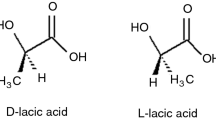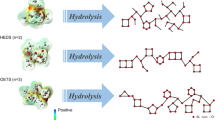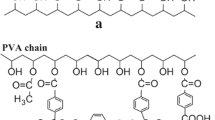Abstract
Piperidinocarbonylmethyl methacrylate (PyCMMA) and 1-(piperidinocarbonyl) ethylmethacrylate (PyCEMA) monomers were synthesized. Polymerizations of PyCMMA and PyCEMA were carried out by atom transfer radical polymerization. The structure of monomers and polymers was characterized by 1H-NMR, 13C-NMR, and FT-IR spectroscopies. Characterization of poly(PyCMMA) and poly(PyCEMA) were carried out using differential scanning calorimetry and gel permeation chromatography. The experimental results showed that the reaction exhibited characteristics of controlled polymerization. The thermal degradation behaviors of poly(PyCEMA) and poly(PyCMMA) were studied using thermogravimetry and a single line vacuum system consisting of a degradation tube with a condenser for product collection. The poly(PyCEMA) and poly(PyCMMA) were heated from ambient temperature to 325 and 500 °C, respectively. The products of degradation were collected as a cold ring fraction (CRF). The CRFs of degradation were investigated by means of IR, 1HNMR, and GC-MS. For the degradation of both polymers, the major products of CRFs are piperidinocarbonyl methanol and 1,2-dipiperidino,1-oxo ethane. The GC-MS, IR, and NMR data showed that depolymerization below 325 °C to the corresponding monomer was not prominantin the thermal degradation of poly(PyCMMA). The mode of thermal degradation including formation of the major products was identified.












Similar content being viewed by others
References
Matyjaszewski K. Transition metal catalysis in controlled radical polymerization: atom transfer radical polymerization. Chem Eur J. 1999;5:3095–102.
Patent TE, Matyjaszewski K. Copper(I)-catalyzed atom transfer radical polymerizations. Acc Chem Res. 1999;32:895–903.
Matyjaszewski K, editor. Controlled/living radical polymerization. Washington DC: American Chemical Society; 1998.
Otsu T, Yoshida M. Role of initiator-transfer agent-terminator (iniferter) in radical polymerizations: polymer design by organic disulfides as iniferters. Makromol Chem. 1982;3:127–32.
Nair CPR, Clouet G. Thermal iniferters: their concept and application in free radical polymerization. J Macromol Sci. 1991;C31(2–3):311–40.
Solomon DH, Rizzardo E, Cacioli PP. Free radical polymerization and the produced polymers. US Patent 4, 581, 429; (Chem. Abstr., 102, 221335q); 1986.
Christe`le B, Emmanuel B, Elodie BL, Philippe C, Nathalie Z, Nitroxide-mediated polymerization of styrene initiated from the surface offumed silica. Comparison of two synthetic routes. Polymer. 2005;46:8502–10.
Georges MK, Veregin RPN, Kazmaier PM, Hamer GK. Narrow molecular weight resins by a free-radical polymerization process. Macromolecules. 1993;26(11):2987–8.
Hawker CJ. Molecular weight control by a “living” free-radical polymerization process. J Am Chem Soc. 1994;116:11185–6.
Chiefari J, Chong YKB, Ercole F, Krstina J, Jeffery J, Le TPT, Mayadunne RTA, Meijs GF, Moad CI, Moad CL, Moad G, Rizzardo E, Thang SH. Living free-radical polymerization by reversible addition-fragmentation chain transfer: the RAFT Process. Macromolecules. 1998;31:5559–62.
Granel C, Dubois P, Jerome R, Teyssie P. Controlled radical polymerization of methacrylic monomers in the presence of a bis(ortho-chelated) aryl nickel(II) complex and different activated alkyl halides. Macromolecules. 1996;29:8576–82.
Wang JS, Matyjaszewski K. Controlled/“living” radical polymerization atom transfer radical polymerization in the presence of transition-metal complexes. J Am Chem Soc. 1995;117:5614–5.
Patent TE, Xia J, Abernathy T, Matyjaszewski K. Polymers with very low polydispersities from atom transfer radical polymerization. Science. 1996;272:866–8.
Matyjaszewski K, Patent TE, Xia J. Controlled/“living” radical polymerization. Kinetics of the homogeneous atom transfer radical polymerization of styrene. J Am Chem Soc. 1997;119:674–80.
Qiu J, Matyjaszewski K. Polymerization of substituted styrenes by atom transfer radical polymerization. Macromolecules. 1997;30:5643–8.
Coca S, Jasieczek CB, Beers KL, Matyjaszewski K. Polymerization of acrylates by atom transfer radical polymerization. Homopolymerization of 2-hydroxyethyl acrylate. J Polym Sci. 1998;36(1):1417–24.
Davis KA, Paik H-J, Matyjaszewski K. Kinetic investigation of the atom transfer radical polymerization of methyl acrylate. Macromolecules. 1999;32:1767–76.
Wang J-L, Grimaud T, Matyjaszewski K. Kinetic study of the homogeneous atom transfer radical polymerization of methyl methacrylate. Macromolecules. 1997;30:6507–12.
Haddleton DM, Jasieczek CB, Hannon MJ, Shooter AJ. Atom transfer radical polymerization of methyl methacrylate initiated by alkyl bromide and 2-pyridinecarbaldehyde imine copper (I) complexes. Macromolecules. 1997;30:2190–3.
Hatada K, Kitayama T, Fujimoto N, Nishiura T. Stability and degradation of polymethacrylates with controlled structure. J Macromol Sci. 1993;30:645–67.
Peniche C, Zaldivar D, Bulay A, Roman JS. Study of the thermal degradation of poly(furfuryl methacrylate) by thermogravimetry. Polym Degrad Stab. 1993;40:287–95.
Manring LE. Thermal degradation of poly(methyl methacrylate). 4. Random side-group scission. Macromolecules. 1991;24:3304–9.
Razga J, Petranek J. Thermal degradation of poly-2-hyroxyethylmethacrylate by pyrolysis gas chromatography. Eur Polym J. 1975;11:805–8.
Bagby G, Lehrle RS, Robb JC. Thermal degradation of poly(methyl methacrylate) in the range 300–500°C. Changes in mechanism confirmed by trends in molecular weight with conversion. Makromol Chem. 1968;119:122–32.
MacCallum JR. The occurrence of weak links in vinyl polymers undergoing thermal degradation. Makromol Chem. 1965;83:129–36.
Zhang X, Yang H, Liu Q, Zheng Y, Xie H, Wang Z, Cheng R. Synthesis and characterization of biodegradable triblock copolymers based on bacterial poly[(R)-3-hydroxybutyrate] by atom transfer radical polymerization. J PolymSci A. 2005;43(20):4857–69.
Martin-Gomis L, Fernandez-Garcia M, de la Fuente JL, Madruga EL, Cerreda ML. Physical properties of PBMA-b-PBA-b-PBMA triblock copolymers synthesized by atom transfer radical polymerization. Macromol Chem Phys. 2003;204(16):2007–16.
Demirelli K, Kurt A, Coşkun M. Thermal degradation and synthesis of block copolymers of styrene and n-butyl methacrylate by atom transfer radical polymerization. Polym Plast Technol Eng. 2004;43(4):1245–63.
Tsuchiya Y, Sumi K. Thermal decomposition products of poly(vinyl alcohol). J. Polym Sci A. 1969;7:3151–58.
Usami T, Itoh T, Ohtani H, Tsuge S. Structural study of polyacrylonitrile fibers during oxidative thermal degradation by pyrolysis-gas chromatography, solid-state carbon-13, NMR, and Fourier-transform infrared spectroscopy. Macromolecules. 1990;23:2460–5.
McNeill IC; Mahmood T. Thermal degradation studies of methacrylonitrile polymers and copolymers. 1.Polymethacrylonitrile prepared using normal free radical initiators. Polym Degrad Stab. 1994;45:285–91.
Özdemir E, Soykan C, Coşkun M, Ahmedzade MA. Synthesis of methacrylate: its characterization and polymerization. J Macromol Sci. 1997;A34:551–7.
Grant DH, Grassie N. The thermal decomposition of polymethacrylic acid. Polymer. 1960;1:125–34.
Coşkun MF, Demirelli K, Coşkun M, Doğru M. Thermal decomposition of poly[3-phthalimido-2-hydroxypropyl methacrylate]. Polym Degrad Stab. 2002;76:145–54.
Coskun M, Barim G, Demirelli K. Thermal stabilities of poly(N-acryloyl-N′-methylpiperazine), its blends with poly(methyl methacrylate), and poly(N-acryloyl-N′-methylpiperazine-co-methyl methacrylate). J Macromol Sci. 2006;A43(1):83–93.
Soykan C, Ahmedzade M. Thermal degradation of poly(phenacyl methacrylate). Polym Degrad Stab. 2002;78(3):497–503.
Demirelli K, Kurt A, Coşkun M. Atom transfer radical polymerization of 1-phenoxycarbonyl ethyl methacrylate monomer. Eur Polym J. 2003;40:451–7.
McNeill IC. Polymer degradation and characterization by thermal volatilization analysis with differential condensation of products. Eur Polym J. 1970;6:373–95.
Grassie N. Chemistry of high polymer degradations processes. London: Butterwords; 1956.
Coşkun M, Erten H, Demirelli K, Ahmedzade M. Thermal degradation of poly[3-(1-cyclohexyl)azetidinyl methacrylate]. Polym Degrad Stab. 2000;69:245–9.
Harley SL, Mittleman ML, Wilkie CA. Preparation and thermal degradation of copolymers of 2-sulfoethyl methacrylate and methyl methacrylate. Polym Degrad Stab. 1993;39:345–54.
Acknowledgements
The authors thank the Firat University Research Fund for financial support to these Projects (FUBAP-656 and FUBAP-1650).
Author information
Authors and Affiliations
Corresponding author
Rights and permissions
About this article
Cite this article
Demirelli, K., Kaya, E., Coşkun, M. et al. Thermal degradation of two different polymers bearing amide pendant groups prepared by ATRP method. J Therm Anal Calorim 114, 917–926 (2013). https://doi.org/10.1007/s10973-013-2986-6
Received:
Accepted:
Published:
Issue Date:
DOI: https://doi.org/10.1007/s10973-013-2986-6




